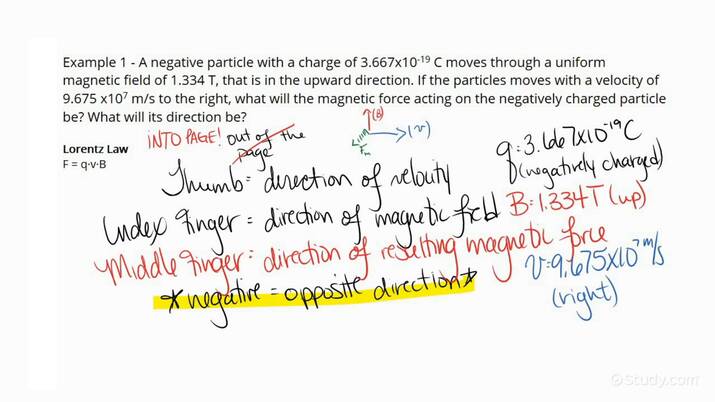
You must cCreate an account to continue watching
Register to access this and thousands of other videos
Try Study.com, risk-free
As a member, you'll also get unlimited access to over 88,000 lessons in math, English, science, history, and more. Plus, get practice tests, quizzes, and personalized coaching to help you succeed.
Get unlimited access to over 88,000 lessons.
Try it risk-freeAlready registered? Log in here for access
BackAlready registered? Log in here for access
Calculating the Direction of a Magnetic Force on a Moving Charge in a Magnetic Field
Step 1: Read the problem.
Step 2: Use the Right-Hand rule to determine the direction of the magnetic force on the moving charge in the magnetic field.
Step 3: Once you determine the direction of the magnetic force on the moving charge in the magnetic field, use Lorentz Law to calculate the value of the magnetic force.
What is a Magnetic Force?
Magnetic Force: It is a force that describes the relationship between particles that are electrically charged. The relationship deals with the attraction or aversion between charged particles.
Lorentz Law Formula: To calculate the magnetic force on a charged particle Lorentz Law can be used as seen below:
$$F=q~ v \times B $$
where {eq}F {/eq} is the magnetic force measured in Newton (N), {eq}q {/eq} is the charge of the particle measured in coulombs (C), {eq}v {/eq} is the velocity of the particle measured in meters per second (m/s), and {eq}B {/eq} is the magnetic field measured in Tesla (T)
Moving Charged Particle: A charged particle is a particle that has an electric charge.
The following two examples will demonstrate how to calculate the direction of a magnetic force on a moving charge in a magnetic field.
Examples of Calculating the Direction of a Magnetic Force on a Moving Charge in a Magnetic Field
Example 1
If a positive particle with a charge of {eq}1.5 \times 10^{-19} {/eq} C moves through a uniform magnetic field of 0.5 T, that is in the downward direction, with a velocity of {eq}5 \times 10^{7} {/eq} m/s to the right, what will the magnetic force acting on the positively charged particle be? What will its direction be?
Step 1: Read the problem.
Based on the Problem, we know that we can use the Right-Hand Rule to determine the direction of the magnetic force as well as Lorentz Law to calculate its value.
Step 2: Use the Right-Hand rule to determine the direction of the magnetic force on the moving charge in the magnetic field.
From the rule, we can determine that the Magnetic Force will go into the page.
Step 3: Once you determine the direction of the magnetic force on the moving charge in the magnetic field, use Lorentz Law to calculate the value of the magnetic force.
We can now use Lorentz Law to calculate the value of the magnetic force by inserting the values given within the problem into the equation$$F= (1.5 \times 10^{-19} C)~ (5 \times 10^{7} m/s) \times (0.5 T) = 3.75 \times 10^{-12} Newton (N) $$
Example 2
If a negative particle with a charge of {eq}1.1 \times 10^{-19} {/eq} C moves through a uniform magnetic field of 0.6 T, that is in the downward direction, with a velocity of {eq}4.3 \times 10^{7} {/eq} m/s to the right, what will the magnetic force acting on the negatively charged particle be? What will its direction be?
Step 1: Read the problem.
Based on the Problem, we know that we can use the Right-Hand rule to determine the direction of the magnetic force as well as Lorentz Law to calculate its value.
Step 2: Use the Right-Hand rule to determine the direction of the magnetic force on the moving charge in the magnetic field.
From the rule, we can determine that the Magnetic Force will go out of the page.
Step 3: Once you determine the direction of the magnetic force on the moving charge in the magnetic field, use Lorentz Law to calculate the value of the magnetic force.
We can now use Lorentz Law to calculate the value of the magnetic force by inserting the values given within the problem in the equation $$F= (1.1 \times 10^{-19} C)~ (4.3 \times 10^{7} m/s) \times (0.6 T) = 2.84 \times 10^{-12}Newton (N) $$
 Jump to a specific example
Jump to a specific example










